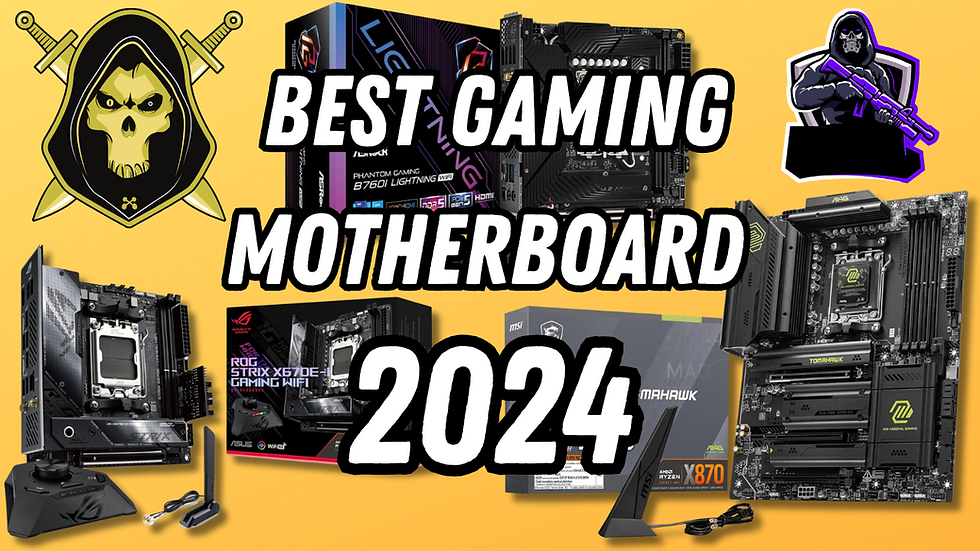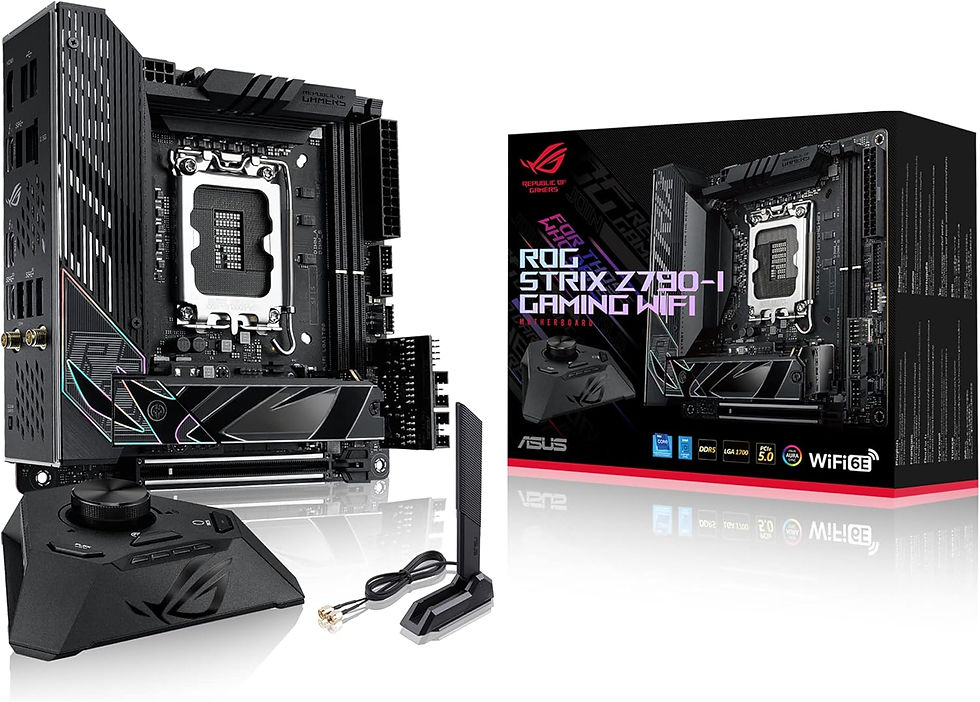
Ultimate Z890 Motherboard Buyer's Guide: Features, Specs, and Top Picks
- arytechblog
- Jan 19
- 7 min read
Updated: Jan 26
The Intel 15th-Gen range of CPUs (aka Intel Core Ultra) launched in October 2024, accompanied by a new wave of Z890 motherboards. These motherboards offer significant upgrades over their predecessors, including better overclocking performance for both CPUs and RAM, expanded Gen5 support, improved high-speed IO, and a push for DIY-friendly features. However, with a crowded market and a wide array of options, choosing the best Z890 motherboard for your build can be overwhelming. That’s where we come in.
This blog is an Amazon affiliate, which means that if you click on a paid link from this website that takes you to Amazon and you purchase a product, I will receive a small commission. You can find links to Amazon in the highlighted words.
In this guide, we analyze their specifications, designs, pricing, and overall value. Whether you’re a performance enthusiast or working on a budget-friendly build, we’ve got recommendations for you.
Our Top Pick Motherboard:
The MSI MEG Z890 UNIFY-X stands out as the best Z890 motherboard, thanks to its exceptional overclocking performance, robust feature set, and user-friendly design. It’s an excellent choice for enthusiasts who want to push their systems to the limit.
Key Features
The MEG Z890 UNIFY-X is built for overclocking enthusiasts, featuring 9600MT/s RAM overclocking support (limited to two DIMMs) and a 20+2+1+1 VRM power phase design. It offers excellent thermal performance and stability, allowing you to unlock the full potential of Intel’s Core Ultra processors.
Design:
A clean black PCB with tool-less heatsinks gives the board a minimalist yet sophisticated look. There’s also customizable RGB lighting on the rear IO heatsink to sync with the rest of your build.
Connectivity:
This motherboard includes two Gen5 PCI-E GPU and SSD slots, ensuring blazing-fast storage and future-proofing for upcoming graphics cards. The rear IO offers 12 high-speed USB ports, including two Thunderbolt4 Type-C ports, along with 5 Gigabit LAN and WiFi 7 for superior networking performance.
Pros and Cons
Pros:
Ideal for overclocking
Robust rear IO and networking options
Gen5 expansion for GPUs and SSDs
Cons:
Limited to two DIMM slots
Expensive compared to entry-level options
Specification | |
Form Factor | ATX |
Supported Memory | 128GB DDR5 9600MT/s |
PCI-E x16 Slots | 2 x PCI-E 5.0 1 x PCI-E 4.0 |
PCI-E x4 Slots | 2 x PCI-E 5.0 4 x PCI-E 4.0 |
Front IO | 2 x USB 2.0 2 x USB 3.2 Gen1 Type-A 1 x USB 3.2 Gen2x2 Type-C |
Rear IO | 2 x Thunderbolt4 Type-C 8 x USB 3.2 Gen2 Type-A 2 x USB 3.2 Gen2 Type-C |
Audio | 1 x Optical S/PDIF 2 x Audio Jacks |
Networking | 5 Gigabit LAN WiFi 7 |
The MSI MEG Z890 UNIFY-X is the ultimate choice for enthusiasts who prioritize overclocking and raw performance. With exceptional RAM overclocking capabilities, robust VRMs, and DIY-friendly features, this motherboard is a top-tier option. However, the limited two-DIMM RAM configuration might not appeal to all builders, and its premium price reflects its high-end design. Still, for those seeking cutting-edge performance, this is the board to beat.
Best Premium Motherboard:
The ASUS ROG MAXIMUS Z890 HERO is a premium option for those seeking cutting-edge performance and a sleek design. It features a 22+1+2+2 VRM power phase design and supports RAM speeds of up to 9200MT/s, making it perfect for high-performance builds.
Key Features
The Z890 HERO is a favorite among gamers and enthusiasts alike, thanks to its six SSD slots (three Gen5 and three Gen4), ample rear IO, and dual-LAN networking (2.5 Gigabit and 5 Gigabit). Its all-black design, paired with large heatsinks for thermal efficiency, adds a professional aesthetic to any build.
Connectivity:
This board includes 11 USB ports on the rear IO, including two Thunderbolt4 Type-C ports and multiple Gen2 and Gen1 ports. Networking is excellent, with both dual-LAN and WiFi 7 support.
Downsides:
Audio options are limited to two 3.5mm jacks and optical S/PDIF, which may be a drawback for audiophiles. Additionally, at around $700, it’s one of the pricier Z890 motherboards.
Pros and Cons
Pros:
Excellent VRM for overclocking
Plenty of SSD expansion slots
Premium design
Cons:
Limited audio output
High price point
Specification | |
Form Factor | ATX |
Supported Memory | 192GB DDR5 9200MT/s |
PCI-E x16 Slots | 1 x PCI-E 5.0 1 x PCI-E 4.0 |
PCI-E x4 Slots | 3 x PCI-E 5.0 3 x PCI-E 4.0 |
Front IO | 1 x USB 3.2 Gen2x2 Type-C 1 x USB 3.2 Gen2 Type-C 2 x USB 3.2 Gen1 Type-A 2 x USB 2.0 |
Rear IO | 2 x Thunderbolt 4 Type-C 4 x USB 3.2 Gen2 Type-A 1 x USB 3.2 Gen2 Type-C 4 x USB 3.2 Gen1 Type-A |
Audio | 1 x Optical S/PDIF 2 x Audio Jacks |
Networking | 2.5 Gigabit LAN 5 Gigabit LAN WiFi 7 |
The ASUS ROG MAXIMUS Z890 HERO strikes a balance between aesthetics and performance, making it an excellent choice for builders who want a feature-packed, stylish motherboard. Its extensive VRM power design and support for high RAM speeds are ideal for overclockers, while its multiple SSD slots provide plenty of storage expansion. However, the high price and limited CPU overclocking potential make it better suited for users prioritizing other features over maximum processor
performance.
Best Budget Motherboard:
If you’re building on a budget but don’t want to sacrifice too many features, the MSI Pro Z890-A WiFi is a fantastic entry-level option. While it lacks some of the advanced capabilities of more expensive boards, it still offers great value.
Key Features
This motherboard supports RAM speeds of up to 9200MT/s and features a 16+1+1+1 VRM power phase design, which is sufficient for moderate overclocking. It has one Gen5 GPU slot and one Gen5 SSD slot, alongside three additional Gen4 SSD slots for storage flexibility.
Connectivity:
The rear IO includes two Thunderbolt4 Type-C ports, three USB 3.2 Gen2 Type-A ports, and four USB 3.2 Gen1 Type-A ports, making it well-equipped for most needs. Networking options include 5 Gigabit LAN and WiFi 7, ensuring stable connections.
Design:
The white heatsinks on the board cater to light-themed builds, but the contrasting black PCB may clash with other components.
Pros and Cons
Pros:
Affordable price point
Solid RAM overclocking potential
Gen5 support for GPU and SSD
Cons:
Basic aesthetic
Limited CPU overclocking capabilities
Specification | |
Form Factor | ATX |
Supported Memory | 256GB DDR5 9200MT/s |
PCI-E x16 Slots | 1 x PCI-E 5.0 2 x PCI-E 4.0 |
PCI-E x4 Slots | 1 x PCI-E 5.0 3 x PCI-E 4.0 |
Front IO | 2 x USB 2.0 1 x USB 3.2 Gen1 Type-A 1 x USB 3.2 Gen2x2 Type-C |
Rear IO | 2 x Thunderbolt4 Type-C 4 x USB 3.2 Gen1 Type-A 3 x USB 3.2 Gen2 Type-A 1 x USB 3.2 Gen2 Type-C |
Audio | 1 x Optical S/PDIF 2 x Audio Jacks |
Networking | 5 Gigabit LAN WiFi 7 |
The MSI Pro Z890-A WiFi offers a fantastic blend of affordability and functionality, catering to those on a budget without compromising too much on features. With Gen5 expansion, impressive RAM overclocking, and solid networking capabilities, it’s a strong entry-level choice. However, its aesthetics and limited CPU overclocking potential may deter users seeking a more premium or visually cohesive design.
Best Mid-Range Motherboard:
The Gigabyte Z890 AORUS Elite WiFi7 is a reliable mid-range motherboard that brings solid performance and decent features, albeit with some limitations compared to other Z890 options.
Key Features
This board features a 16+1+2 VRM power phase design and supports up to 256GB of DDR5 RAM at 9200MT/s. It includes one Gen5 GPU slot and one Gen5 SSD slot, along with three Gen4 SSD slots for additional storage.
Connectivity: The rear IO is slightly underwhelming, with only six high-speed USB ports alongside four USB 2.0 ports. Networking includes 2.5 Gigabit LAN and WiFi 7, which deliver stable and fast internet connections.
Drawbacks: While it’s a solid choice overall, this motherboard shares many similarities with its predecessor, the Z790 AORUS Elite, making it less compelling for those considering an upgrade.
Pros and Cons
Pros:
High RAM overclocking potential
Gen5 GPU and SSD support
Thunderbolt4 compatibility
Cons:
Limited rear IO (USB 2.0 ports)
Not a significant upgrade from Z790
Specification | |
Form Factor | ATX |
Supported Memory | 256GB DDR5 9200MT/s |
PCI-E x16 Slots | 1 x PCI-E 5.0 2 x PCI-E 4.0 |
PCI-E x4 Slots | 1 x PCI-E 5.0 3 x PCI-E 4.0 |
Front IO | 1 x USB 3.2 Gen2 Type-C 1 x USB 3.2 Gen1 Type-A 2 x USB 2.0 |
Rear IO | 1 x Thunderbolt 4 Type-C 2 x USB 3.2 Gen2 Type-A 3 x USB 3.2 Gen1 Type-A 4 x USB 2.0 |
Audio | 1 x Optical S/PDIF 2 x Audio Jacks |
Networking | 2.5 Gigabit LAN WiFi 7 |
The Gigabyte Z890 AORUS Elite WiFi7 is a well-rounded motherboard that provides decent overclocking support and ample SSD expansion at a competitive price. While it offers notable improvements like Gen5 compatibility, the similarities to its Z790 predecessor might make upgrading less appealing. Additionally, the inclusion of USB 2.0 ports on the rear IO feels outdated. Despite these drawbacks, it remains a reliable option for gamers and general users seeking solid performance on the Z890 platform.
Conclusion:
Which Z890 Motherboard Is Right for You?
The Z890 chipset brings an impressive range of features and performance improvements, but the right motherboard depends on your specific needs and budget.
For enthusiasts and overclockers, the MSI MEG Z890 UNIFY-X is the best option, offering unparalleled performance and a DIY-friendly design.
If you prefer premium aesthetics and SSD expansion, the ASUS ROG MAXIMUS Z890 HERO is an excellent choice, provided you’re willing to pay a premium.
Budget-conscious builders should consider the MSI Pro Z890-A WiFi, which offers great value without compromising too much on features.
Lastly, if you’re looking for a reliable mid-range option, the Gigabyte Z890 AORUS Elite WiFi7 is a solid pick, though it might not offer enough to justify upgrading from the Z790 generation.
Each motherboard in this roundup caters to different use cases, so choose the one that aligns with your build goals. With any of these boards, you’ll have a strong foundation for a next-generation Intel Core Ultra build!







Comments